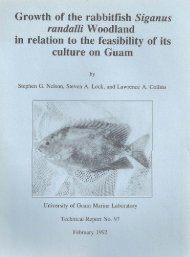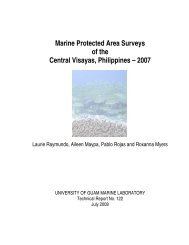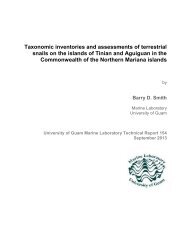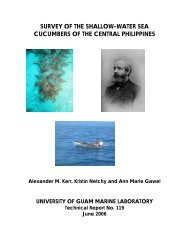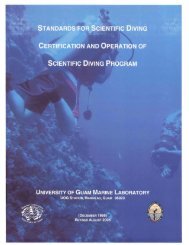MARINE BIOLOGICAL SURVEY OF THE PROPOSED DOCK SITE ...
MARINE BIOLOGICAL SURVEY OF THE PROPOSED DOCK SITE ...
MARINE BIOLOGICAL SURVEY OF THE PROPOSED DOCK SITE ...
Create successful ePaper yourself
Turn your PDF publications into a flip-book with our unique Google optimized e-Paper software.
•12The outermost part of the reef-flat platform called the Sandand Coral zone consists of a region dominated by sand-sized sedimentsand scattered to locally abundant, massive, hemispherical shapedPorites colonies. Some of these colonies attain a diameter of ameter or more and up to 80 cm in height. Although coral density,coverage, and species diversity is greater in this zone than for anyother, there is no apparent structural reef development taking place,except for possibly a minor amount at Transect 3 where the outeredge of the reef-flat platform forms a slightly raised topographiclip (Fig. 2). Even though the wide range of coverage measured onthe transects (1.10-6.7~ %, Table 3) reveals the patchy and unevendistribution of corals along the zone there is a general increase incoral density, coverage, and diversity from the inner to outer part.The lagoon slope was not quantitatively analyzed because of thefew corals observed there. In general corals are more abundant alongthe upper slopes where more light and less sedimentation occurs thanalong the lower part, although locally where the slope flattens outto the lagoon floor local aggregations of deeper water species suchas Leptoseris scabra, Alveopora allingi, and Goniopora sp. 1 arefound. It appears that the lagoon slope has been altered by previousdredging and the surface consists of rather unstable rubble and sand.Coral planulae may settle on the larger pieces of more stable rubble,but as they increase in size, these colonies would tend to slumpquite easily downslope to more unfavorable growing conditions.Observations on the upper lagoon slope revealed that except for smallsized colonies most corals were aggregated where uncommon exposuresof more stable large blocks and boulders were exposed.A total of 17 genera and 41 sp"cies of reef-huilding cnralswpre found within the study region enclosed by the area betweenTransects 1 and 4 (Fig. 1). Compared to the rich fauna (over 100species) observed along the reef-flat platforms near the outer partof Tomil Harbor Channel the coral fauna at this study site is ratherdepauperate. An earlier study, conducted near the present study sitea few kilometer to the southeast at Donitsch Island, revealed a somewhatintermed1ate coral tauna composed of 31 genera and 81 species(Amesbury et al., 1976). This attenuation of coral species alongthe length of Tomil Channel is for the most part caused by a generaldeterioration of the more optimum conditions for coral growth foundnear the mouth of the channel toward its head near the study area.Because of the close proximity of land and surface drainage at thestudy area, the water is conSiderably more turbid and the accumulationof silt on the reef ~urface greater than at rpef areas loca~edfart"her se~ward. PreViOl)S distllrbance at the stuny site by dredging,land filling, and construction has also influenced the coralcommunity to an undetermined degree. It is suspected that the pres~ntlagoon slupe is particular and parts of the reef-tlat platform aredepauperate (16-23 species, Table 2) because of previous dredging.





